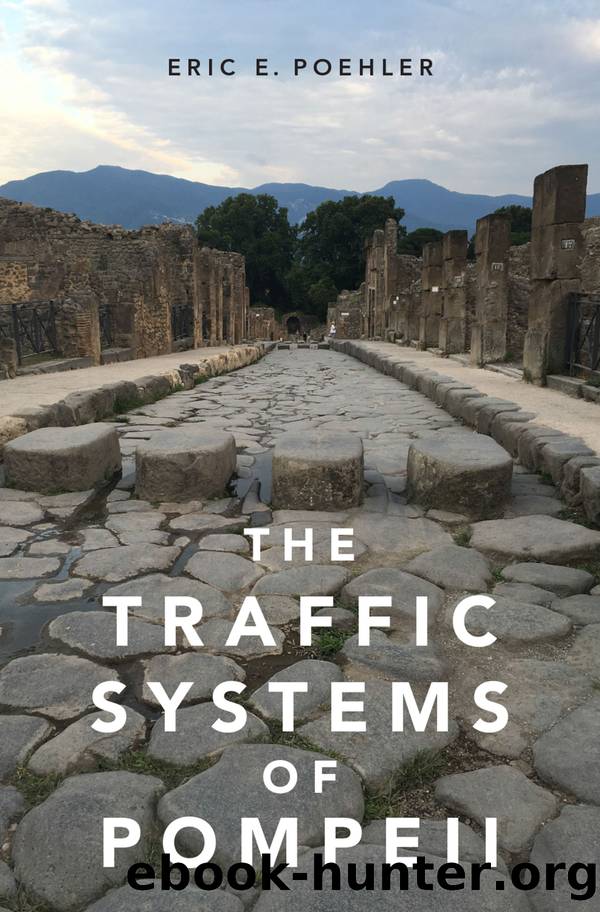Traffic Systems of Pompeii (9780190668709) by Poehler Eric E

Author:Poehler, Eric E.
Language: eng
Format: epub
Publisher: Oxford Univ Pr
Published: 2017-09-15T00:00:00+00:00
6
The Traffic Systems of Pompeii
With the evidence for direction and how to interpret it now fully explored, an obvious question arises: how was the consistency of behavior that produced more than six hundred patterns of directional wear produced? To put it another way and to pose the title of this book as a question, were there traffic systems at Pompeii governing the circulation of vehicles? One of the first ways to approach this question is simply to reflect on the surprising consistency of behavior that these wearing patterns record: inscribed over years, each one of the thousands of iterations tells the same story of a vehicle traveling in the same direction, turning away at the same place, and sliding against or riding up over the same street features. That such exceptional coherence exists in each wearing pattern, on its own, strongly suggests a shared set of expectations for how driving would be conducted. Within a single piece of evidence is a record of each time that a Pompeian cart driver made the same choice as the drivers before him, a fact not only multiplied by the thousands of identical choices but also amplified by the absence of equivalent opposite directional wearing.
If we can read a shared intent among drivers from a single object, the next step must be to treat these objects as an assemblage and assess how well such moments of shared intent add up across the breadth of an entire city. Although this evidence and the question it is turned toward is novel, the notion that archaeologists can surmise rules and even entire systems from artifacts and architecturesâsettlement patterns, local or regional economies, or bathing regimesâis not. What is different, however, is that there are no direct literary sources to start from, to prove or disprove. The observations, their interpretation, and their aggregation must stand or fall almost entirely on archaeological grounds. Fortunately, the data are up to the task and reveal the presence of a city-wide system that evolved over at least a century. To describe the system, or rather systems, the totality of the data is considered through several filters that make up the structure of this chapter, including approaches that are structural (the shape of the street network), directional (the evidence for two-way and one-way streets), and chronological (the evolution of the system over time).
Download
This site does not store any files on its server. We only index and link to content provided by other sites. Please contact the content providers to delete copyright contents if any and email us, we'll remove relevant links or contents immediately.
| Acoustics | Bridges |
| Earthwork Design | Environmental |
| Fire Science | Highway & Traffic |
| Hydrology | Remote Sensing |
| Seismic Design | Structural |
| Structural Dynamics | Surveying & Photogrammetry |
| Transportation |
Whiskies Galore by Ian Buxton(41938)
Introduction to Aircraft Design (Cambridge Aerospace Series) by John P. Fielding(33092)
Small Unmanned Fixed-wing Aircraft Design by Andrew J. Keane Andras Sobester James P. Scanlan & András Sóbester & James P. Scanlan(32764)
Craft Beer for the Homebrewer by Michael Agnew(18197)
Turbulence by E. J. Noyes(7978)
The Complete Stick Figure Physics Tutorials by Allen Sarah(7338)
Kaplan MCAT General Chemistry Review by Kaplan(6900)
The Thirst by Nesbo Jo(6877)
Bad Blood by John Carreyrou(6583)
Modelling of Convective Heat and Mass Transfer in Rotating Flows by Igor V. Shevchuk(6406)
Learning SQL by Alan Beaulieu(6237)
Weapons of Math Destruction by Cathy O'Neil(6215)
Man-made Catastrophes and Risk Information Concealment by Dmitry Chernov & Didier Sornette(5956)
Digital Minimalism by Cal Newport;(5704)
Life 3.0: Being Human in the Age of Artificial Intelligence by Tegmark Max(5516)
iGen by Jean M. Twenge(5385)
Secrets of Antigravity Propulsion: Tesla, UFOs, and Classified Aerospace Technology by Ph.D. Paul A. Laviolette(5333)
Design of Trajectory Optimization Approach for Space Maneuver Vehicle Skip Entry Problems by Runqi Chai & Al Savvaris & Antonios Tsourdos & Senchun Chai(5037)
Pale Blue Dot by Carl Sagan(4954)
